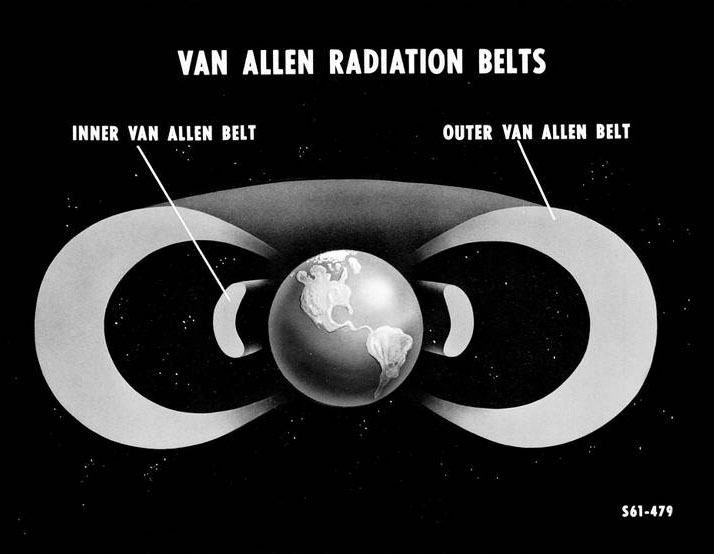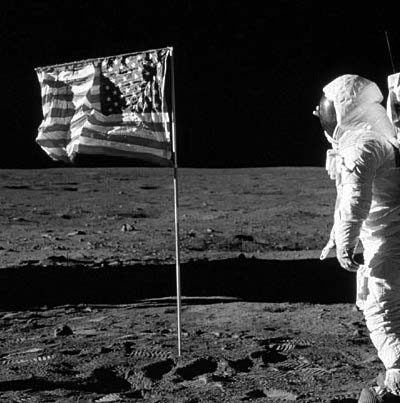The astronauts could not have survived the trip because of exposure to radiation from the Van Allen radiation belt and galactic ambient radiation (see radiation poisoning and health threat from cosmic rays). Some conspiracists have suggested that Starfish Prime (a high-altitude nuclear test in 1962) was a failed attempt to disrupt the Van Allen belts.
There are two main Van Allen belts – the inner belt and the outer belt – and a transient third belt. The inner belt is the more dangerous one, containing energetic protons. The outer one has less-dangerous low-energy electrons (Beta particles). The Apollo spacecraft passed through the inner belt in a matter of minutes and the outer belt in about 1 1⁄2 hours. The astronauts were shielded from the ionizing radiation by the aluminum hulls of the spacecraft. Furthermore, the orbital transfer trajectory from Earth to the Moon through the belts was chosen to lessen radiation exposure. Even Dr. James Van Allen, the discoverer of the Van Allen radiation belts, rebutted the claims that radiation levels were too harmful for the Apollo missions. Plait cited an average dose of less than 1 rem (10 mSv), which is equivalent to the ambient radiation received by living at sea level for three years. The total radiation received on the trip was about the same as allowed for workers in the nuclear energy field for a year and not much more than what Space Shuttle astronauts received.

This early schematic of the Van Allen Belts' structure was created after the first American satellite discovered their existence in 1958. Credits: NASA's Goddard Space Flight Center/Historic image of Van Allen Belts courtesy of NASA’s Langley Research Center
The film was kept in metal containers that stopped radiation from fogging the film's emulsion.[117] Furthermore, film carried by unmanned lunar probes such as the Lunar Orbiter and Luna 3 (which used on-board film development processes) was not fogged.
There is no atmosphere to efficiently bind lunar surface heat to devices (such as cameras) that are not in direct contact with it. In a vacuum, only radiation remains as a heat transfer mechanism. The physics of radiative heat transfer are thoroughly understood, and the proper use of passive optical coatings and paints was enough to control the temperature of the film within the cameras; Lunar Module temperatures were controlled with similar coatings that gave them a gold color. Also, while the Moon's surface does get very hot at lunar noon, every Apollo landing was made shortly after lunar sunrise at the landing site; the Moon's day is about 29½ Earth days long, meaning that one Moon day (dawn to dusk) lasts nearly fifteen Earth days. During the longer stays, the astronauts did notice increased cooling loads on their spacesuits as the sun and surface temperature continued to rise, but the effect was easily countered by the passive and active cooling systems. The film was not in direct sunlight, so it was not overheated.
No large solar flare occurred during the flight of Apollo 16. There were large solar flares in August 1972, after Apollo 16 returned to Earth and before the flight of Apollo 17.
This suggests that it was filmed on Earth and a breeze caused the flag to flutter. Sibrel said that it may have been caused by indoor fans used to cool the astronauts since their spacesuit cooling systems would have been too heavy on Earth.
The flag was fastened to a Г-shaped rod (see Lunar Flag Assembly) so that it did not hang down. The flag only seemed to flutter when the astronauts were moving it into position. Without air drag, these movements caused the free corner of the flag to swing like a pendulum for some time. The flag was rippled because it had been folded during storage – the ripples could be mistaken for movement in a still photo. Videos show that when the astronauts let go of the flagpole it vibrates briefly but then remains still. This theory was further debunked on the MythBusters episode "NASA Moon Landing".

Cropped photo of Buzz Aldrin saluting the flag (the fingers of Aldrin's right hand can be seen behind his helmet)
Moondust has not been weathered like Earth sand and has sharp edges. This allows the dust particles to stick together and hold their shape in the vacuum. The astronauts likened it to "talcum powder or wet sand". This theory was further debunked on the MythBusters episode "NASA Moon Landing".